Cushion Cut Diamond Buying Guide
How to find the perfect cushion cut for your engagement ring
We are reader-supported. Buying through any red colored link on our site may earn us commissions. Learn More.
How to find the perfect cushion cut for your engagement ring
The cushion cut diamond, gaining immense popularity over recent years, characterized by its soft square or rectangular shape with rounded edges, reminiscent of a pillow. Understanding the nuances between standard and modified cushion cuts, as well as their distinct appearances, is crucial for an informed purchase. When shopping for a cushion cut diamond, a general guideline is to stick with a depth and table under 70%.
Cushion cuts also retain color more than other shapes, so look for an H color or better when the diamond is set in platinum, white gold, or silver. A one carat cushion cut costs $2,500 based of our quality recommendation. We’ll discuss all the nuances of cushion cut diamonds and how to navigate the 4 Cs to find the perfect balance of quality and value.
What is a cushion cut diamond?
What are the pros and cons of cushion cut diamonds?
What is a brilliant cut diamond?
How much does a cushion cut diamond cost?
What should I focus on when buying a cushion cut diamond?
What setting style should I choose for a cushion cut diamond?
Cushion cut vs. other shapes
Standard vs. modified cushion cut diamonds
An example of our conversation with one of our reader
Cushion cut diamonds on celebrities
FAQs about cushion cut diamonds
Bottom line recommendation
Why you should trust us
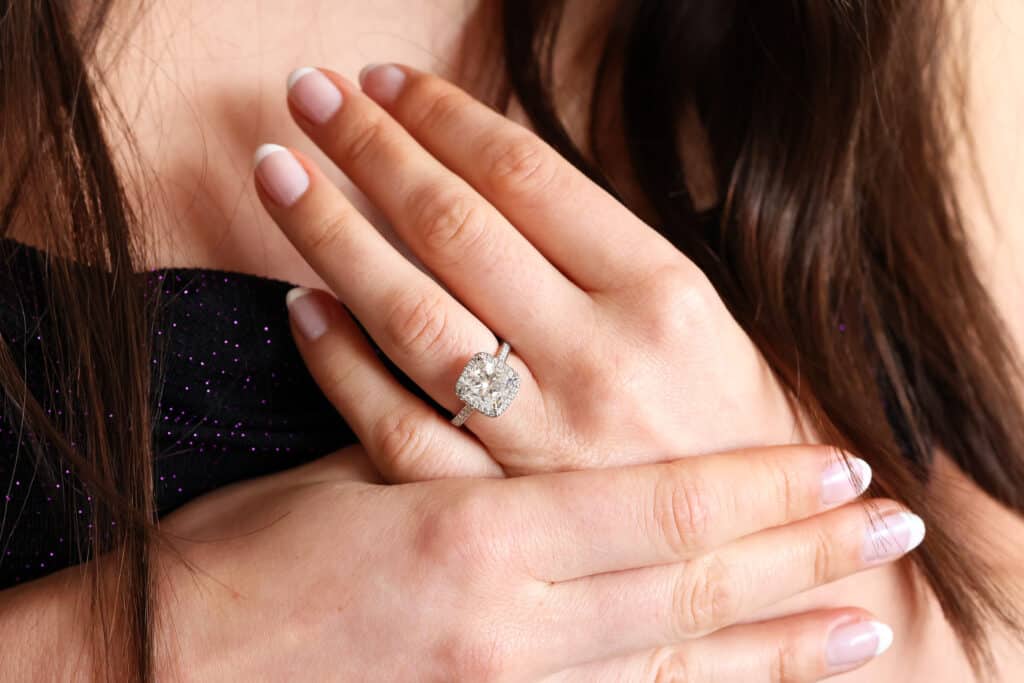
A cushion cut diamond is a fantastic choice that has gained in popularity the last decade. They are especially popular for halo settings, like this stunner from Blue Nile or this one from James Allen. We’ll answer all your cushion cut questions in this article.
A cushion cut diamond is a combination of a more modern and round brilliant cut pattern diamond with a classic, old mine facet pattern diamond cut. This type of diamond typically has a soft square or even rectangular shape, all with curved edges.
Simply put, a cushion cut diamond combines a square cut with rounded corners, giving it an appearance similar to a pillow. This is where the “cushion cut” name comes from.
According to Rapaport “Cushion cuts are popular in matching pairs. They are especially being used in larger-carat earrings.”
Here’s an example of a stunning cushion cut from Blue Nile’s collection. Cushion cut diamonds are often purchased for engagement rings. They’re also commonly used in some fashion pieces.
The price of a cushion cut diamond is typically significantly less than the cost of a round brilliant diamond. However, due to increasing popularity of cushion cut diamond rings, these prices may vary and rise significantly.
Here are some of the distinctive features that you’ll notice from a cushion cut diamond.
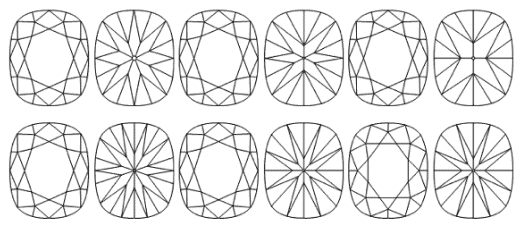
In 2018 JCK Online reported that the 2nd largest rough diamond was cut into 67 diamonds ranging in size from 1 carat to over 100 carats including an 11.2 carat D color flawless cushion cut.
As with any diamond shape, there are advantages and disadvantages. Learn if the cushion cut is right for you.
Pros
Cons
If you’d like help reviewing a cushion cut diamond, ask an expert.
Even though the cushion cut is one of the most popular diamond shapes, the number one has always been the round cut diamond. But that’s not it. There are many more shapes that are popular with people looking for a different, more unique look. If you look at our dedicated page covering all the diamond shapes, you may want to find the shape that suits you the most.
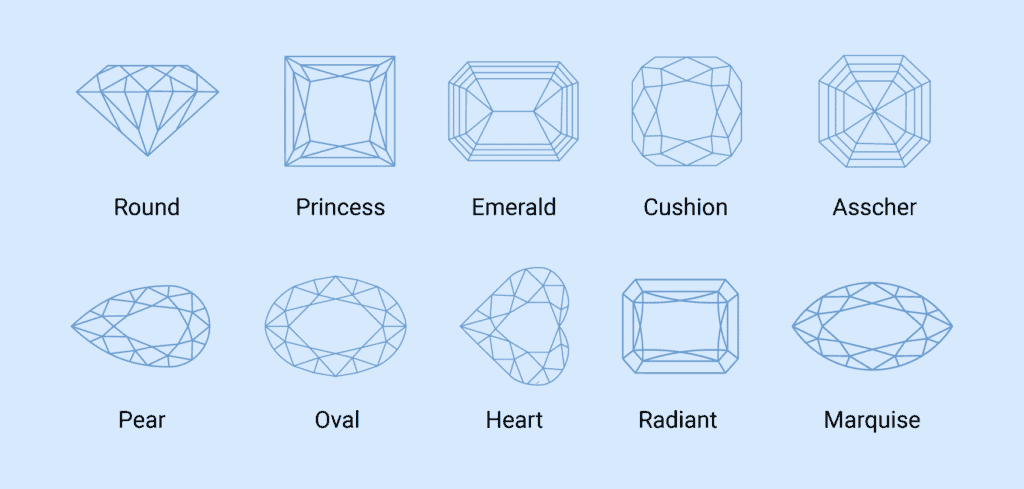
A brilliant is a diamond that has been cut in a form with many facets, so it can have exceptional brilliance and maximized light that is returned through the top of the diamond.
A brilliant cut diamond will most closely resemble a cone in shape and appearance. Round brilliant cut diamonds are considered the “ideal” diamond cut and are easily the most desirable type of diamond available.
Pro Tip: Even though round diamonds are the most brilliant shape, that is only one aspect when purchasing a diamond. Your own personal style matters most. If you had your heart set on a cushion cut halo, the difference in brilliance between this stunner from Blue Nile and a round diamond won’t be that noticeable.
Just a very general guideline, try to stick to cushions with a depth under 70% and a table under 70%. People will tell you that lower is better, but I’ve seen plenty of very beautiful cushion cuts with depths at 70% and tables at 70%.
If you start to go above those markers, the diamond can have a very dead look. Take this diamond from James Allen for example. Due to its depth, there is virtually no sparkle to the diamond.
The price of a cushion cut diamond ring depends on numerous factors. The diamond’s carat weight makes a massive difference, so too the diamond’s grades in cut, color and clarity, and the style of setting you choose.
For a 1 carat cushion cut diamond, with grades of H for color and SI1 in clarity (like this 1ct cushion cut from James Allen), you can expect to pay somewhere around $3,500. On top of that, factor in anywhere from $500 to $1500 for a setting, to complete your ring.
You can save money by going with a lower grade in color or clarity, but it’s likely to be to the detriment of the diamond’s beauty.
Similarly, you can go for higher grades in these areas, which will cost quite a lot more. This 1.01 carat, E/VVS2 cushion cut diamond, for instance, is priced at $4,690. However, this is not going to give you a significant increase in beauty, when viewed by the naked eye, compared to a diamond several grades lower.
As for lower or higher carat diamonds, a ½ carat cushion cut diamond (with H/SI1 grades) should cost between $700 to $1000. While a 2 carat cushion cut should range from $17,000 to $19,000.



Looking for a cushion cut? Below, I’ve covered the key factors to look for when buying or comparing cushion cut diamonds, from color to clarity.
Cushion cuts are one of the worst shapes when it comes to retaining diamond color (or one of the best, if you’re a manufacturer of fancy color diamonds).
Cushions and radiants are the two most common diamond shapes in the fancy color diamond market. These shapes are on the opposite end of the spectrum from rounds, which are the best at masking their color.
For this reason, I recommend my readers sticking with H or better when buying a cushion cut unless it will be set in yellow or rose gold (in which case, you can go down to J or K).
H color diamond is a good value option. It’s also one of the more popular choices thanks to its balance in price when compared to the natural diamond color. You’ll notice a significant price jump between each color grade, with H falling somewhere in the middle.
Although H diamonds aren’t completely colorless, they are “near colorless” and only have a very slight yellow tint. Almost no one will notice this difference, especially if the diamond is set in rose or yellow gold.
Regarding diamond clarity, a cushion cut can be a bit tricky. Firstly, it’s important to note whether you’re looking to buy a crushed-ice cushion or an “antique” cushion. The reason is simply that the crushed-ice look, in any shape diamond, is generally a very good hider of inclusions.
Additionally, if you’re looking to buy a marquise or pear shape diamond, it’s always best if the inclusions are in the corners as they’ll be very heavily masked by the crushed-ice that’s typically found in the corners of these shapes.
Of course, you’ll only know what kind of cushion look you’ll be buying if you can see a picture of the diamond in question – so it’s already a given that you’d be able to inspect the diamond’s clarity as well. Therefore, like always, shoot for the lowest clarity you can find that’s still eye-clean.
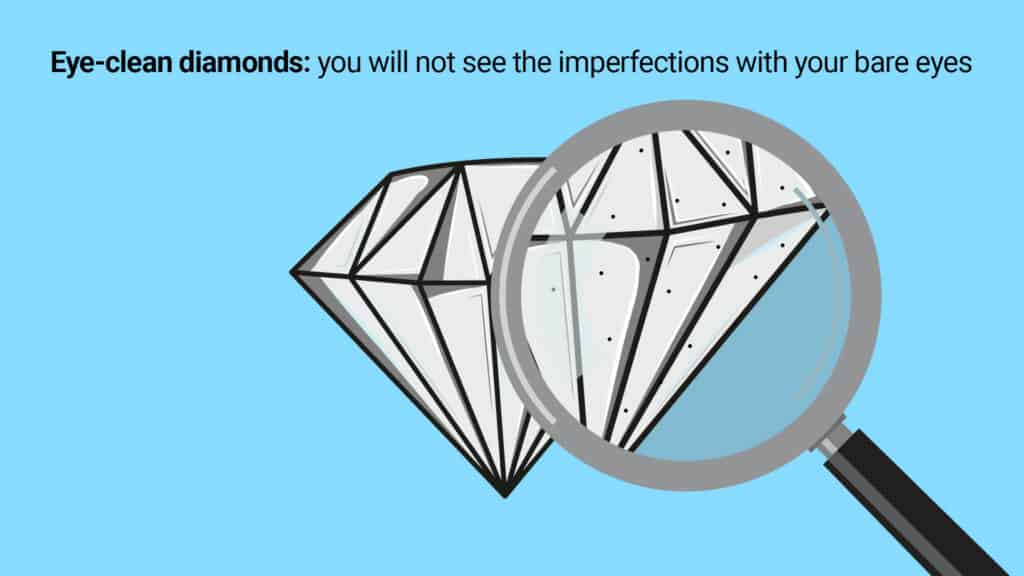
We use “eye-clean” to describe a diamond that looks clear and free from inclusions under normal viewing conditions. While it may have inclusions noticeable under a magnifying glass, microscope, or loupe, the typical person will not be able to see any inclusions with their naked eye.
Because cushion cuts have a large open table, it might be difficult to find a nice eye-clean SI2 diamond. This means you might have to compromise and end up paying a bit extra for a higher clarity stone. You can start your search at SI1 or SI2 clarity, but realize the end goal is an eye-clean stone at the best price.
Ringo™ Approved Eye Clean Diamonds
We recently developed Ringo, which is a patented artificial intelligence model to help consumers pick out the right eye-clean diamond for their ring. Ringo uses videos of diamonds to determine whether or not they are eye-clean, and can filter for additional parameters such as cut quality, fluorescence issues, and to check if it matches your choice of setting style.
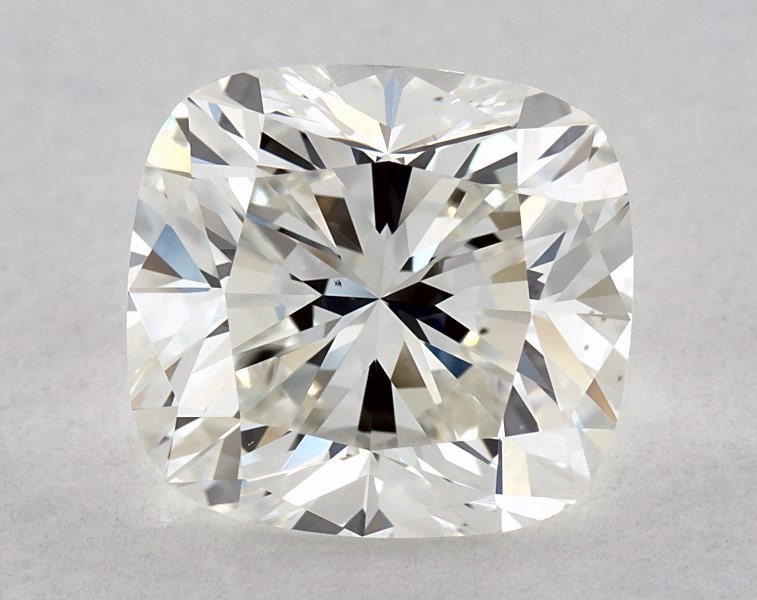


As with the other soft-sided fancy shapes, there aren’t any real hard and fast rules when it comes to the stone’s parameters. Nothing on a certificate will tell you whether or not the stone is an “antique” style cushion or a “crushed-ice” style cushion.
Nothing on the certificate will tell you how rounded the corners are: some cushions are nearly round, and some are nearly square. Therefore, if you are looking to buy a cushion cut diamond it is imperative that you limit yourself to vendors who offer clear magnified pictures of their inventory.
Here are some recommended parameters for cushion cut diamonds:
As you can see, these parameters are very loose. It’s important to remember that with cushion cut diamonds (as is the case with many other soft-sided fancy shapes), you can’t really evaluate a stone’s cut quality by its numbers alone. The best way we can help you with selecting a cushion cut diamond is by making some educated recommendations.
The length and width ratio refer to the proportionate length and width of the diamond and also is a good determinant of how the diamond will look when it is looked at from a face-up view. It is also a good indicator of how big or small the stone will appear to look.
Polish is a grade noted on the lab certificate. It refers to how fine of polish has been applied to the facets of the diamond. This generally has a minimal impact on the diamond price and its look.
Symmetry is also a less important grade on the diamond certificate. It refers to how symmetrical the facets of the diamond have been laid out by the cutter. Both symmetry and polish should always have a minimum grade of “Very Good.”
When you begin to examine the carat of a cushion cut diamond, you will also find that there may be significant differences in the price points due to the emphasis of the carat weight.
The carat weight of a diamond is simply the measurement of how much the diamond actually weighs. The price points begin to go up with increased weights because a larger diamond is typically more sought after for a diamond engagement ring, for example and is more desirable than a smaller diamond and therefore comes at a higher cost.
If you’re not sure how big different carat weights of a cushion cut are (different L:W ratios aside), take a look at this simple comparison to a US quarter.
A cushion cut can make a great choice for a 2 carat diamond ring. Cushion cuts are one of the most affordable diamond shapes, and thus can help you save when buying a large and expensive diamond (such as a diamond 2 carats and above).
Here is a beautiful 2 carat cushion cut diamond. At H color and VS2 clarity, you’re not making any major sacrifices with this diamond to keep the price down, yet the price is around $4,000 less than you would expect to pay for a round brilliant with similar grades.
The girdle on a diamond is the perimeter dividing the crown (the top part of the diamond) and the pavilion (the section below).
People will also tell you to avoid “extremely thick” girdles, but on cushions, this is much less of an issue. Cushion cut girdles are almost always chunky, so there isn’t much you can do about it.
Obviously, if you have two seemingly equivalent stones, and one has a medium girdle, and the other has an extremely thick girdle, you should buy the one with the medium girdle.
But this rarely happens. You should first look to find a nice-looking cushion that is an H color or higher with as low of a clarity grade as possible that’s still eye clean in as large of a diamond as possible that fits your budget.
Only after you accomplish that should you focus on girdle thickness.
Shop for cushion cut diamond engagement rings here.
Would you like help finding the right cushion cut diamond? Contact us and let us know what your budget is and we’ll send you some personalized recommendations.
We can also help answer any questions you may have regarding the 4C’s: cut, color, clarity, and carat weight.
Because of their classic appeal and modern charm, cushion cuts look stunning in a variety of engagement ring styles. Here’s the rundown on the best engagement ring styles for cushion cut diamonds.
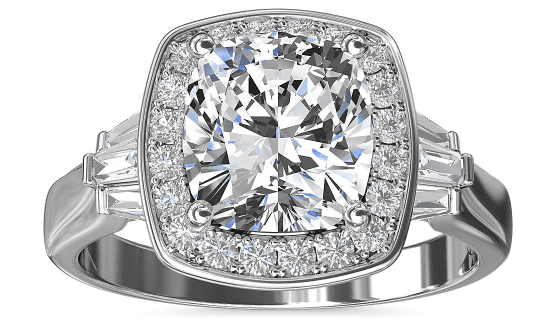
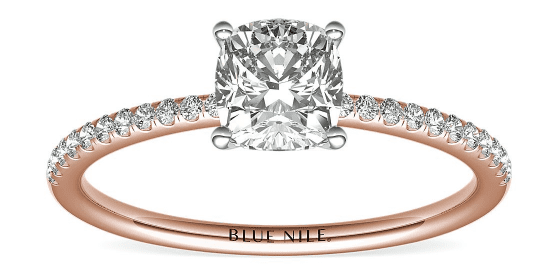
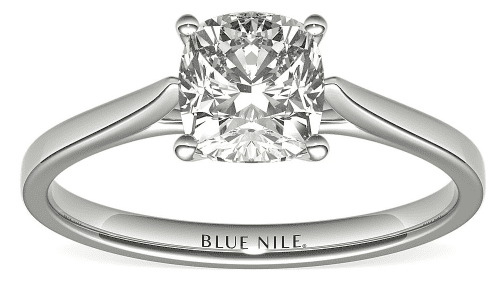
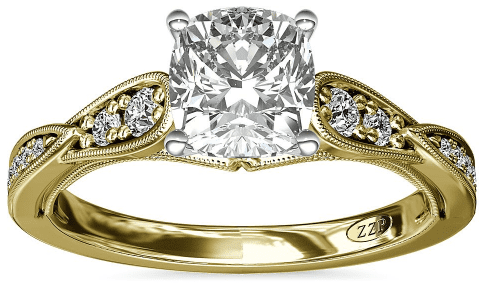
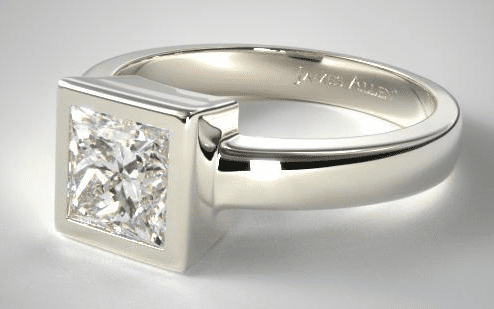
After rounds and princess cuts, the shape I hear about most lately is the cushion cut. I think there are two primary reasons for this.
Firstly, and most obviously, cushion cuts are simply more popular now than they have ever been before. They manage to look elegant and understated while still bringing a level of brilliance almost equal to a round diamond like in this pavé engagement ring from James Allen.
Almost as important as this is the fact that a cushion cut is simply a very confusing cut. There are a whole host of terms specific to cushion cuts that need to be understood, such as modified cushions, classic cushions, chunky cushions, broken glass, crushed ice, no culets, large culets, old minders, square cushions, and rectangular cushions.
This leaves you with many choices to make when considering a cushion cut diamond, as well as the choice of similarly shaped diamonds, such as round, princess and radiant cuts.

Wondering if you should choose a cushion cut or a round cut diamond? Here are a few things to keep in mind:
If you’re debating between a cushion cut and a princess cut, here are a few points to consider.
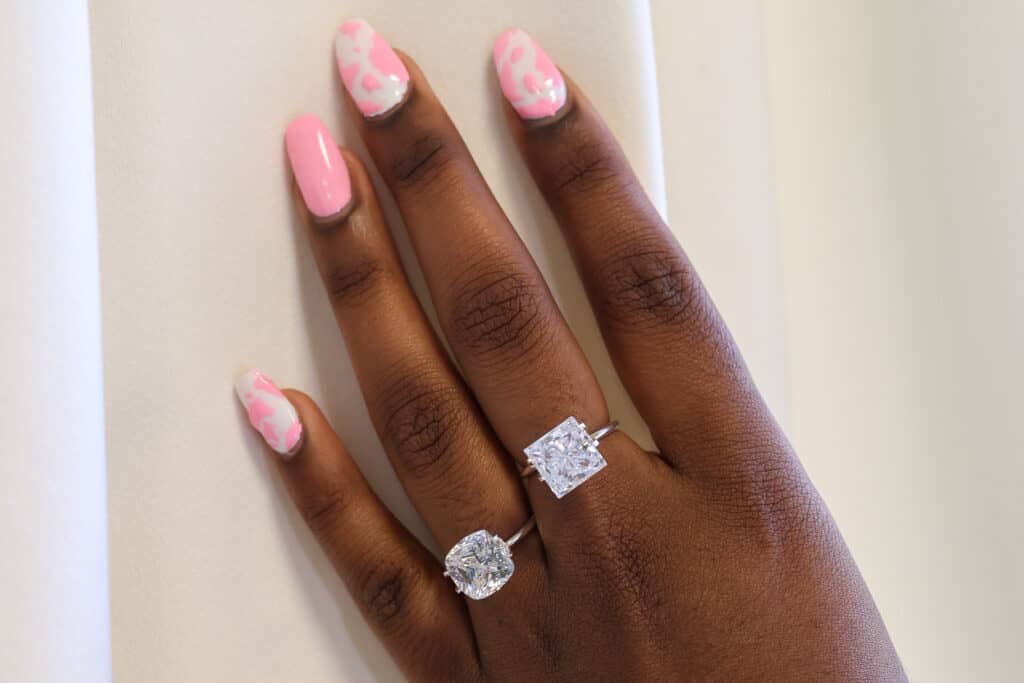
Cushion cuts and radiant cuts are similar but distinct shapes. These pointers can help decide which one (cushion vs radiant) is right for you.
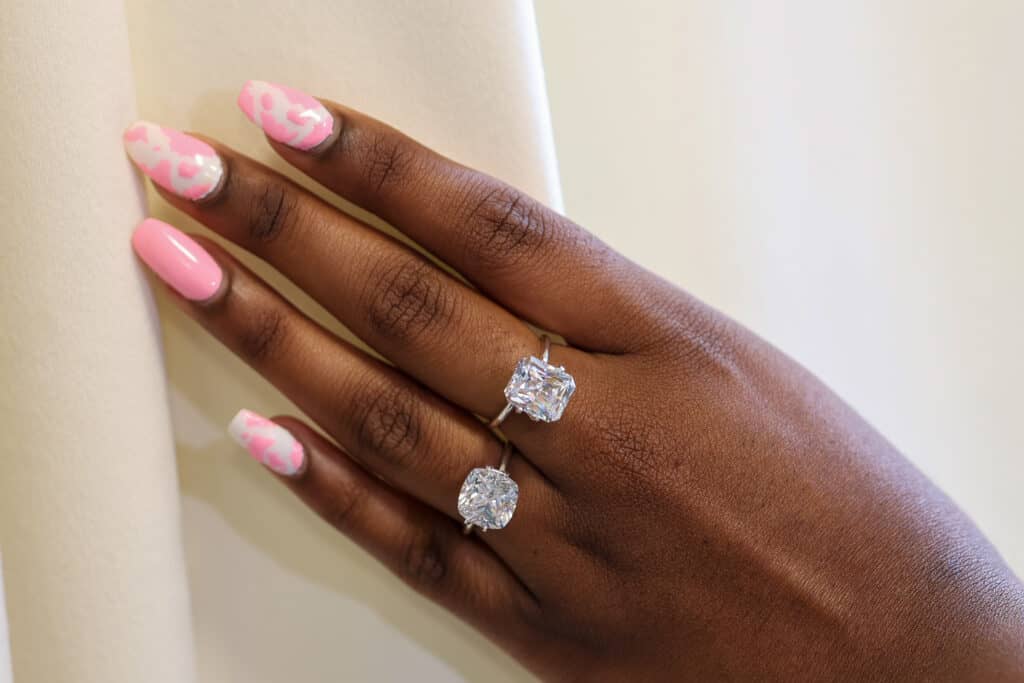
Just like with other diamonds and precious gemstones, it’s important to look at any cushion cut diamond’s certification before you make a purchase. In general, you’ll want to look for diamonds certified by the Gemological Institute of America (GIA). The GIA is the most reliable gemological laboratory in the world, making their certification the most important to look for.
By looking at the GIA certification, you don’t need to listen as closely to what the store is saying regarding the quality of the diamond. Instead, the GIA certification offers an external, reputable and unbiased appraisal of the diamond.
Factors such as the cut, color, clarity, carat weight and much more are evaluated for each stone and all appear as part of the certificate.
Modern cushion cuts can be classified into one of two main categories: standard or modified. You can view the differences between the two in the two collections of plot diagrams shown on this page.
Above, you can see the collection of standard cushion cut facet plots and to the right, the collection of modified cushion cut facet plots.
Likewise, I have posted to the right and to the left sample GIA certificates correlating to the two cushion cut styles.
For a better understanding, take a look at the videos of this standard cushion cut on James Allen and this modified cushion cut on James Allen.
As you can see, the differences between standard and modified cushions are rather minute and technical in nature. Their effect on a stone’s appearance is likewise fairly minimal.
The only thing that really differentiates between the two is history. The standard cushions are the cutting styles that have been around longer while the modified cushions are simply modern variations on the original cushion cut facet patterns.
The single greatest mistake people make regarding cushion cuts is that it actually makes a significant difference to the stone’s appearance whether it’s a standard cushion or a modified cushion.
In fact, if you’ve reached this page after doing research elsewhere, I’m sure you’ve already heard that line several times before.
People will tell you that you need to buy a standard cushion if you want a “chunky cushion” (see below) and you need to buy a modified cushion if you want a “crushed ice” cushion (also below).
This is completely inaccurate. The truth about cushion cuts is that it rarely makes any kind of noticeable difference in a cushion cut’s appearance whether it’s standard or modified.
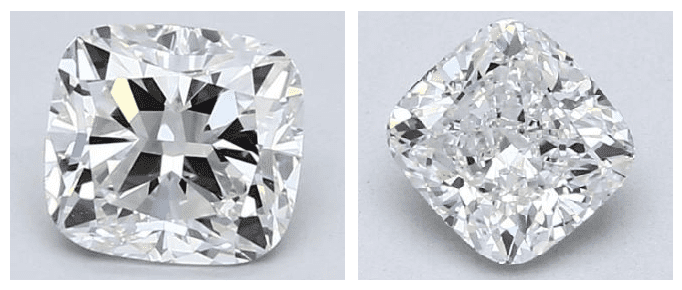
Just as there are two distinct categories of cut classifications of cushions, so too are there two distinct categories of “looks” that a cushion cut diamond can display.
Before we discuss these two categories, however, it’s worth stressing again that there is absolutely no correlation between the two groups of cut configurations and the two types of exhibited “looks.”
“Chunky” cushions are those that have clearly defined facet patterns when looking down into the table of a face-up oriented stone.
These tend to resemble the way in which round diamonds present themselves. These are often called “antique” cushion cuts.
This is actually technically not true since the cushion brilliant cut is relatively modern. The Old Miner is the antique antecedent to the modern cushion cut. Although, it’s clear this look is referred to as an “antique” cushion because this is how Old Miner cuts always present themselves.
“Crushed-Ice” cushions are those that have no discernible faceting when you look through their table. All you can see is what looks like broken glass or crushed-ice (hence the name) – a disorganized space of sparkling bling.
This is typically what a radiant cut looks like. You also find this effect in corners of pear shapes and marquise shape stones.
If you’d like to see the difference between these two looks – the easiest way to understand it is by looking at the two diamond shapes that most exemplify each “look”: radiants for “crushed ice” and rounds for the clean cut look of the “chunky” cushions.
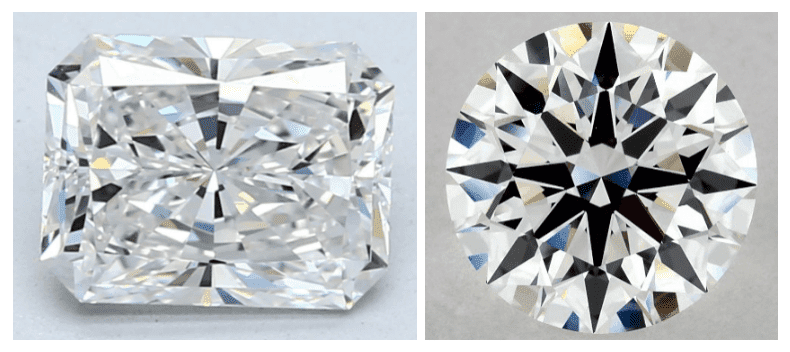
Above is a typically crushed ice radiant. Notice in the picture of the round stone to the right how clearly defined and symmetrical each of the facets are and how different that is from the radiant to the left.
Now just to drive the point home, I didn’t choose those two pictures of cushion cuts above at random.
It happens to be that the “antique/chunky” cushion in the picture above and to the left is a GIA certified cushion modified brilliant. It also happens to be that the “crushed-ice” cushion in the picture above and to the right is a standard “cushion brilliant.”
I have a question about cushion cut diamonds. I have noticed that some of the diamonds I have looked at on James Allen have certificates that have the statement “crown angles greater than 40 degrees” under additional comments.
What type of effect does this have on the diamond (other than lower price)? I know that crown angle is important in round brilliant cuts but if the diamond is rated as an excellent cut why does the crown angle matter?
Here is an example of one that I was looking at: www.jamesallen.com/loose-diamonds/cushion-cut/1.07-carat-g-color-vvs1-clarity-sku-5628769
Which do you think is the better deal?
Thanks for your time.
It seems like you have this diamond buying process down pat. I love the second diamond you selected. I would choose between that one and this one:
www.jamesallen.com/loose-diamonds/cushion-cut/1.21-carat-h-color-vs1-clarity-sku-5065870
Depending whether you prefer the crushed ice look or the antique chunky look. I didn’t like the G you selected.
Let me know how it looks when it arrives.
Thanks for your quick response. I was already leaning toward the H that I previously sent but just out of curiosity’s sake what made the G not as likeable? I understand the clarity is high and not cost effective vs an eye-clean diamond of lower clarity and it is smaller than the H but where these the only reasons?
Also, I will be using this setting: www.jamesallen.com/engagement-rings/pave/platinum-petite-pave-engagement-ring-item-56283
Would that change anything since the side stones are F-G and the diamond I am considering is an H?
Thanks again for your advice.
The H color is fine with those settings. As for the G, I didn’t like the faceting of the diamond. Cushion cuts don’t have the same standards for faceting as round/princess diamonds do. It looks like that one is a cross between a crushed ice and antique look (no doubt done to save weight while cutting).
Thanks Mike. I am in the process of talking to James Allen about these two diamonds:
www.jamesallen.com/loose-diamonds/cushion-cut/1.20-carat-h-color-vvs2-clarity-sku-6026296
I know the only difference is antique vs crushed ice so I have asked them to compare the stones to see which one looks more brilliant. Thanks again for your help. I will be sure to let them know you helped when I make my purchase.
The difference between those is purely stylistic. I wouldn’t have an opinion.
Let me know what happens.
I went with this diamond. www.jamesallen.com/loose-diamonds/cushion-cut/1.20-carat-h-color-vvs2-clarity-sku-5619429
I had a James Allen’s gemologist compare the two diamonds and he said that one outperformed the other. It should get here by Friday. I’ll let you know what I think when I get to see it and I’ll send a picture.
Thanks again for your help.
Sounds great.
I got the ring from James Allen last week and couldn’t be happier with it.
Thanks for writing and letting us know. I’m delighted that you were pleased with our help. We wish you and your partner a life of happiness and fulfillment.
Did you know? Many celebs propose with cushion cuts.
See how many of these engagement rings you already know about.
There are a raft of other diamond shapes that are popular with both everyday consumers and celebrities. These cuts can provide a similar look to a cushion diamond, or a unique point of difference if you’re looking for a different style.
Here are a few answers to frequently asked questions regarding cushion cut diamond engagement rings.
A cushion cut diamond is a square or rectangular shaped diamond, with a brilliant cut facet style. Cushion cuts have rounded corners, giving them a pillow or cushion-like appearance.
Cushion cut diamonds usually have 58 facets. However, this can vary, and some modern variations of the cushion cut have 64 facets.
The price of a 2 carat cushion cut diamond can differ greatly depending on other characteristics, such as its cut, color and clarity grades. For a standard 2 carat cushion cut, with grades near to H for color and SI1 for clarity, you should expect to pay somewhere between $17,000 to $19,000.
We understand there are a lot of things to look for when shopping for a diamond ring, and that this can be scary for someone without much experience. That’s why our experts are here to help.
Contact us for help searching for the perfect cushion cut ring. We’ll help you choose between different cushion cut styles, assess diamond clarity, cut quality, and other important factors, and match it to a setting to create the ideal engagement ring for your significant other.
In this article we will cover everything you need to know about cushion cut diamonds and how to get the best bang for your buck. Here are some key points that you shouldn’t forget while searching:
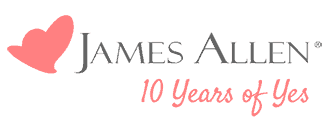



Before you buy a diamond, get personal buying advice from industry veterans. We'll help you get the best diamond for the money.
DISCLAIMER: We don't use your email for marketing. Period.
A diamonds’ price is determined primarily by the 4 Cs of the diamond. On the wholesale level, diamond prices are first based on a diamond shape and
Buying an engagement ring is often one of the first major purchases in a person's life. The process can be fraught with tension as there are so m
A wide range of 1 carat diamonds exist both in online markets and local diamond jewelry stores. Not only are there significant differences in beauty
Please enter your email address to receive your 25% off coupon code:
Here is your coupon code: GFDSF3GF